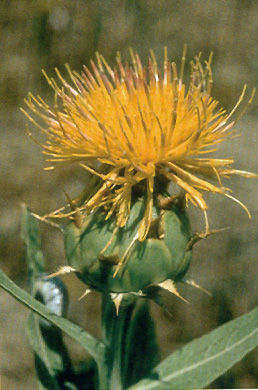Tomanthea carthamoides: Red Data Book of Armenia

CR A 2 abc; B 1 ab(i,ii,iii,iv,v) + 2ab(I,ii,iii,iv,v); C 1+2(i); D
Category. Critically endangered species. It is known from one floristic region. The extent of occurrence and area of occupancy are less than 10 km2. Grows in the area of intensive land development. It was included in the first edition of the Red Data Book of Armenia under Category 1: Endangered species. It is not included in the Annexes of CITES and that of the Bern Convention.
Description. Perennial herbs. Stems erect, unbranched or weakly branched, ivory–coloured, 15–40 cm. Leaves coriaceous, entire, elliptic or lanceolate, with prominent thick veins, decurrent, amplexicaul. Capitula heterogamous, many–flowered, large, terminal, solitary, ovate; involucre phyllaries coriaceous, smoth, with narrowly triangular appendages. Flowers golden yellow, sticky. Pappus double, setae fine ciliate.
Distribution. In Armenia it occurs in Yerevan (foothills of Urts mountain range, surroundings of Surenavan) floristic region. AOO is 8 km2, the number of locations is 1. Besides Armenia the species grows in North–East Anatolia (Turkish Armenia – Mush, Van).
Ecological, biological and phytocoenological peculiarities. Grows in lower mountain belt, at the altitude of 700–900 meters above sea level, on dry stony slopes, in semi–desert, among phryganoid vegetation. Flowering from June to July, fruiting from July to August.
Limiting factors. Restricted extent of occurrence and area of occupancy, loss/degradation of habitats caused by land development.
Conservation actions. No conservation actions. Necessary: search of new habitats, monitoring of the population state.
Suggestions
 The Ministry of Environment sent a letter international partners to draw their attention to the real danger of environmental disasters as a result of Azerbaijan's large-scale aggression towards the territory of Armenia
The Ministry of Environment sent a letter international partners to draw their attention to the real danger of environmental disasters as a result of Azerbaijan's large-scale aggression towards the territory of Armenia
 Vicia pisiformis: Red Data Book of Armenia
Vicia pisiformis: Red Data Book of Armenia
 Vavilovia formosa: Red Data Book of Armenia
Vavilovia formosa: Red Data Book of Armenia
 Trigonella capitata: Red Data Book of Armenia
Trigonella capitata: Red Data Book of Armenia
 Trigonella astroides: Red Data Book of Armenia
Trigonella astroides: Red Data Book of Armenia












